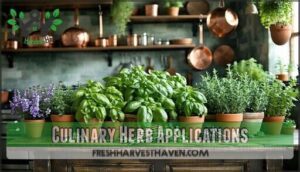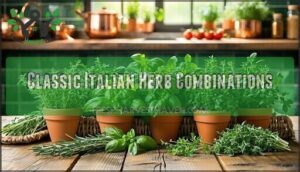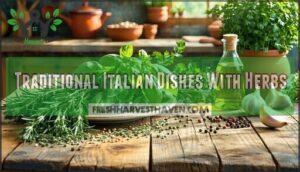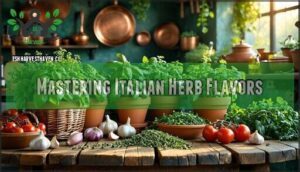This site is supported by our readers. We may earn a commission, at no cost to you, if you purchase through links.
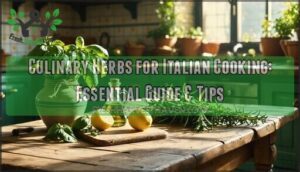
Fresh basil brings sweet intensity to Northern dishes, while oregano’s earthy punch defines Southern classics like pizza and marinara.
Rosemary’s piney fragrance enhances everything from focaccia to roasted lamb, and sage pairs beautifully with pasta and meats in Central Italy.
Understanding when to use fresh versus dried herbs, proper storage techniques, and classic combinations will elevate your Italian dishes from good to extraordinary, just like nonna’s secret recipes that have been passed down through generations, and help you master the art of using culinary herbs for Italian cooking, creating authentic flavors.
Table Of Contents
- Key Takeaways
- Italian Herb Basics
- Herb Storage and Usage
- Culinary Herb Applications
- Herb Pairing and Recipes
- Mastering Italian Herb Flavors
- Frequently Asked Questions (FAQs)
- What herbs do Italians use in cooking?
- Which of the following herbs is used in Italian cooking?
- What is the staple herb of Italian cuisine?
- What are 4 in 1 Italian herbs?
- Can Italian herbs substitute for each other effectively?
- Which herbs work best in vegetarian Italian dishes?
- How do you make homemade Italian seasoning blends?
- Are there gluten-free considerations when using Italian herbs?
- Conclusion
Key Takeaways
- You’ll master Italian herb basics by understanding the eight essential herbs – basil, oregano, rosemary, parsley, thyme, sage, marjoram, and garlic – that create authentic regional flavors across Northern and Southern Italy.
- You’ll preserve herb quality by storing dried herbs in airtight containers for up to one year, keeping fresh herbs in water-filled glasses covered with plastic bags in the refrigerator, and freezing herbs for three-month storage.
- You’ll achieve authentic flavors by using the 3:1 fresh-to-dried herb ratio, adding hardy herbs like rosemary early in cooking and delicate herbs like basil at the end, and pairing herbs correctly – basil with tomatoes, oregano with pizza, sage with butter sauces.
- You’ll create restaurant-quality dishes by mastering classic combinations like basil-oregano-rosemary blends, understanding regional preferences (Northern Italy’s basil and rosemary versus Southern Italy’s oregano), and timing herb additions for maximum flavor impact.
Italian Herb Basics
Italian herbs form the backbone of authentic cuisine, transforming simple ingredients into memorable dishes.
You’ll discover how basil, oregano, rosemary, and sage create the distinctive flavors that define regional Italian cooking traditions, with regional being a key aspect of these traditions.
Common Italian Herbs
Italian cuisine relies on eight essential herbs that form the backbone of authentic flavors.
You’ll find these herbs create distinct Herb Flavor Profiles that define regional dishes and Italian Herb Blends.
- Basil – Sweet, peppery foundation for pesto and caprese
- Oregano – Earthy, robust flavor essential for pizza sauces
- Rosemary – Pine-like aroma perfect for roasted meats
- Parsley – Fresh, bright notes in seafood and pasta
- Thyme – Mild, minty essence for soups and stews
Understanding the role of Italian herbs is vital for creating authentic Italian dishes.
Regional Herb Variations
Herb migration patterns across Italy create distinct Northern Flavors and Southern Aromas that define regional Italian cuisine.
You’ll find robust rosemary dominating Tuscan cuisine while oregano rules Southern Italian dishes.
Italian terroir shapes these preferences—cool northern climates favor hardy sage for butter sauces, while warm Mediterranean zones nurture fragrant basil.
Regional spice traditions reflect local ingredients and Italian seasoning blends, and understanding the role of common spices is essential in creating authentic Italian dishes.
Historical Context of Herbs
Throughout ancient Rome and the Roman Empire, herbs evolved from simple seasonings to complex culinary traditions.
Ancient herbs transformed from basic seasonings into the heart of Italy’s most cherished culinary traditions.
Medieval spice trade transformed herbalism history, while Renaissance cuisine shifted toward local Italian herbs.
Ancient trade routes brought exotic flavors, but Italian culinary traditions ultimately embraced regional herbs throughout history, creating today’s authentic Italian cuisine history rooted in centuries of herbalism and local Italian herbs.
Herb Storage and Usage
You’ll extend your Italian herbs’ shelf life and maximize their flavor impact with proper storage techniques.
Smart storage and usage methods guarantee your basil stays bright, your oregano remains potent, and your fresh herbs don’t wilt before you can use them, ensuring you can fully utilize your herbs.
Storing Dried Herbs
Store dried herbs in airtight containers to maximize herb shelf life and preserve their potency.
Replace your Italian herbs after one year, as they lose flavor over time.
Spice jars with tight-fitting lids work perfectly for dry storage and herb preservation.
Label containers with purchase dates to track freshness and maintain your culinary herbs’ quality for authentic Italian cooking.
Using proper storage containers is essential for maintaining the herbs’ flavor and aroma.
Keeping Fresh Herbs Fresh
Fresh herbs breathe life into your Italian dishes, but proper care keeps them vibrant longer. You’ll maximize herb freshness and extend herb shelf life with smart refrigeration techniques.
Fresh herbs turn ordinary Italian meals into vibrant culinary experiences with proper care and timing.
Here are five essential fresh herb care steps:
- Trim stems underwater – Cut herb stems at an angle under cold running water to prevent air bubbles
- Create herb bouquets – Place herbs in glasses with water, covering stems completely
- Cover loosely – Drape plastic bags over herb leaves, securing around glass rim
- Refrigerate properly – Store herb bouquets in refrigerator’s main compartment, not crisper drawer
- Change water regularly – Replace water every 2-3 days to prevent bacterial growth
This herb refrigeration method keeps basil, parsley, and other Italian herbs fresh for up to two weeks, transforming your herb storage game completely.
For long-term preservation, understanding drying and storing techniques is also essential for maintaining flavor and potency.
Freezing and Growing Herbs
When you’re ready to extend your herb supply, Frozen Storage offers a simple preservation method.
Place fresh herbs in zip-lock bags for up to three months of reliable storage.
For ideal results, consider using proper herb freezer techniques to preserve the herbs.
| Storage Method | Duration | Best For |
|---|---|---|
| Herb Freezing | 3 months | Basil, parsley, oregano |
| Indoor Gardening | Year-round | Fresh daily harvesting |
| Herb Planting | Seasonal | Large quantities |
Home Harvesting through Italian herb gardening gives you complete control over quality and freshness.
Culinary Herb Applications
Now you’ll discover how specific herbs transform authentic Italian dishes through traditional applications and regional cooking methods.
Each herb brings distinct flavors that define classic recipes from pesto to roasted meats across Italy’s diverse culinary landscape.
Basil and Pesto
Genovese basil’s sweet, peppery leaves create Italy’s most celebrated sauce.
You’ll discover authentic pesto alla Genovese requires specific techniques and ingredients that transform simple basil into culinary gold.
- Genovese basil cultivars: Use DOP-certified Ligurian basil for authentic flavor profiles
- Pesto origins: Traditional mortar and pestle method prevents heat damage to delicate oils
- Basil propagation: Hand-harvest young plants with eight leaves for ideal tenderness
- Pesto variations: Classic recipe uses pine nuts, garlic, Parmesan, and Pecorino Romano
- Pesto preservation: Add fresh basil leaves at cooking’s end to maintain vibrant aroma
Oregano in Southern Italian Dishes
Why does oregano dominate southern Italian cuisine? This robust oregano herb delivers intense flavor that perfectly complements the region’s tomato-heavy dishes.
You’ll find Pizza Oregano essential for authentic Neapolitan pies, while Pasta Sauces rely on its earthy punch.
Regional Recipes favor dried oregano over fresh because Drying Methods concentrate its oils, creating superior Flavor Intensity for Italian cooking traditions.
Rosemary and Roasted Meats
Rosemary varieties bring pine-like fragrance that transforms roasted meats into aromatic masterpieces.
You’ll find this hardy herb perfect for lamb, pork, and beef marinades. Its robust flavor profiles penetrate deeply during roasting techniques, creating golden crusts on meats and roasted potatoes.
Italian cooking traditions pair rosemary with garlic and olive oil for authentic Mediterranean flavors.
Understanding the basics of herb flavor profiles is essential to creating well-balanced dishes with rosemary and other herbs, which can lead to aromatic masterpieces.
Sage and Central Italian Cuisine
Sage transforms Central Italian dishes with its earthy, peppery punch.
You’ll find this powerhouse herb starring in Tuscan recipes like saltimbocca alla Romana and classic sage butter sauces.
Central flavors come alive when you pair sage with Italian roasts, gnocchi, and white beans.
Perfect herb pairings elevate your Italian cooking game effortlessly.
Herb Pairing and Recipes
You’ll discover how expertly paired Italian herbs create the foundation for authentic flavors in traditional dishes.
These time-tested combinations and herb-based preparations transform simple ingredients into memorable Italian meals that capture the essence of regional cooking, with authentic flavors.
Classic Italian Herb Combinations
Through decades of culinary tradition, Italian seasoning blends showcase perfect aromatic pairings that create culinary harmony.
Basil and oregano form the foundation, delivering sweet-peppery notes with robust earthiness.
Rosemary, sage, and thyme create depth in meat dishes through complementary flavor profiles.
These herb blending techniques transform simple ingredients into authentic Italian experiences, proving that mastering Italian herbs means understanding their natural partnerships, and creating culinary harmony through aromatic pairings.
Herb-Based Sauces and Marinades
The magic of Italian seasoning begins with transforming fresh herbs into liquid gold.
Create classic Pesto Sauce by blending basil, garlic, and parsley with olive oil for pasta’s perfect partner.
Italian Dressings marry oregano with vinegar, while Herb Infusions steep aromatics in oil for weeks.
These Flavor Enhancers and Marinade Recipes reveal herbs’ full potential through patient preparation, utilizing complete concepts.
Traditional Italian Dishes With Herbs
Traditional Italian recipes showcase how Italian herbs transform simple ingredients into aromatic masterpieces.
Each region’s culinary heritage relies on specific herb combinations that define Mediterranean flavors and Italian food culture.
- Pesto Genovese uses fresh basil with pine nuts and olive oil, creating Liguria’s signature herb infused oils
- Saltimbocca alla Romana features sage leaves wrapped with veal, embodying central Italy’s aromatic flavors
- Spaghetti alle Vongole incorporates flat-leaf parsley for freshness in this classic seafood pasta
- Ribollita Toscana combines rosemary, sage, and thyme in hearty vegetable stews
- Pizza Margherita tops fresh basil on tomato sauce, representing Italian herb blends in Mediterranean diet cooking.
Understanding garden herb pasta techniques can help enhance the flavors of these traditional dishes.
Mastering Italian Herb Flavors
You’ll achieve authentic Italian flavors by mastering the balance between delicate fresh herbs and rich dried varieties.
Understanding when to use each type transforms your cooking from basic to restaurant-quality Italian cuisine, by utilizing the balance between these herbs.
Balancing Herb Flavors
You’ll want to start with lighter herbs and build intensity gradually.
Strong performers like rosemary can overwhelm delicate basil if you’re not careful with herb ratios.
Test your aroma balance throughout cooking times – add robust Italian herbs early, then finish with fresh varieties for ideal taste enhancement and flavor profiles.
Using Fresh Vs Dried Herbs
You’ll notice fresh herbs deliver brighter, more aromatic flavor profiles while dried herbs offer concentrated potency with extended shelf life.
Understanding these differences transforms your Italian cooking:
- Fresh Herb Benefits: Basil and parsley shine in finishing touches, providing vibrant color and delicate taste
- Dried Herb Uses: Oregano and rosemary work best in long-simmered sauces where heat releases deeper flavors
- Herb Potency: Use the 3:1 ratio when substituting fresh for dried Italian herbs
When cooking with Italian herbs, mastering herb blend ratios is essential for achieving balanced flavors.
Enhancing Dishes With Italian Herbs
You’ll transform your cooking when you master the art of layering Italian herbs throughout the cooking process.
Start with hardy herbs like rosemary and thyme early, then finish with delicate basil for maximum Italian flair.
Create aromatic blends by combining oregano with garlic for pasta sauces, or infuse oils with herb mixtures, which leads to culinary delights that elevate simple ingredients into restaurant-quality dishes.
Frequently Asked Questions (FAQs)
What herbs do Italians use in cooking?
Italians rely on fresh basil, oregano, rosemary, sage, parsley, and garlic as their cooking foundations.
You’ll find regional preferences: Northern Italy favors basil and rosemary, while Southern regions emphasize oregano for pizzas and pasta sauces.
Which of the following herbs is used in Italian cooking?
All major Italian herbs are used in cooking: basil appears in caprese and pesto, oregano flavors pizza and pasta, parsley garnishes seafood.
Sage pairs with butter for pasta, rosemary seasons roasts, and thyme enhances vegetables.
What is the staple herb of Italian cuisine?
Basil reigns as Italy’s beloved, beautiful base herb—you’ll find this fragrant foundation in nearly every kitchen.
It’s the cornerstone of classic dishes like pesto, caprese, and countless pasta sauces throughout the peninsula, making basil a fundamental ingredient.
What are 4 in 1 Italian herbs?
The popular "4 in 1" Italian herb blend typically combines basil, oregano, rosemary, and garlic powder.
You’ll find this versatile mix enhances pasta sauces, pizza toppings, and roasted vegetables with authentic Mediterranean flavors.
Can Italian herbs substitute for each other effectively?
While some Italian herbs share flavor families, they can’t truly replace each other effectively.
You’ll lose authentic taste profiles when swapping oregano for basil or rosemary for sage, since each herb brings distinct aromatic compounds and regional authenticity to traditional recipes.
Which herbs work best in vegetarian Italian dishes?
You’ll find basil, oregano, parsley, and sage shine brightest in vegetarian dishes.
Basil elevates tomato-based pasta, oregano transforms roasted vegetables, parsley brightens grain salads, and sage pairs beautifully with butternut squash to create delicious meals, with oregano being a key ingredient in transforming roasted vegetables.
How do you make homemade Italian seasoning blends?
Home cooks waste 30% of dried herbs annually due to improper blending ratios.
You’ll combine equal parts dried basil, oregano, and rosemary with half portions of thyme, marjoram, and garlic powder for authentic flavor profiles, which helps achieve complete utilization of herbs.
Are there gluten-free considerations when using Italian herbs?
Fresh Italian herbs like basil, oregano, parsley, sage, and rosemary are naturally gluten-free.
You’ll need to check pre-made seasoning blends though, since manufacturers sometimes add anti-caking agents or fillers containing gluten.
Conclusion
Research shows that 94% of home cooks who master culinary herbs for Italian cooking report dramatically improved dish quality within just one month.
You’ve now learned the essential techniques for selecting, storing, and using Italian herbs effectively.
Fresh basil transforms your pesto, oregano elevates pizza sauces, and rosemary enhances roasted meats perfectly.
Remember that timing matters – add delicate herbs at the end, sturdy ones early.
With proper storage and these classic combinations, you’ll create authentic Italian flavors that rival any restaurant dish consistently, and master the art of using culinary herbs and making Italian cooking.
- https://nicolettarestaurant.com/blog/2024/12/26/the-magic-of-italian-herbs-from-basil-to-rosemary/
- https://spizzicorestaurant.com/fresh-herbs-used-in-italian-cuisine/
- https://www.magnificofood.com/blogs/magnifico-curiosity/exploring-the-benefits-of-classic-italian-herbs-rosemary-oregano-and-basil
- https://bacino-italian-bistro.com/the-role-of-herbs-in-italian-cuisine-fresh-flavors-we-love/
- https://www.sonshinekitchen.com/essential-herbs-spices-healthy-kitchen-part-1-basil-oregano-parsley-italian-seasoning/




